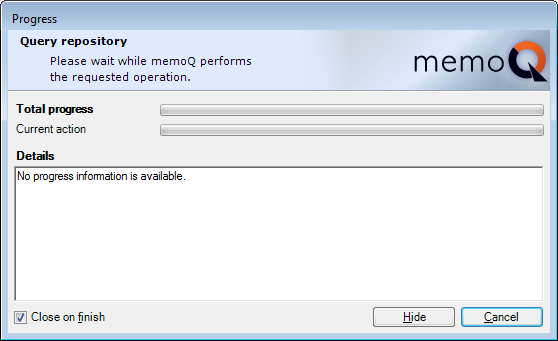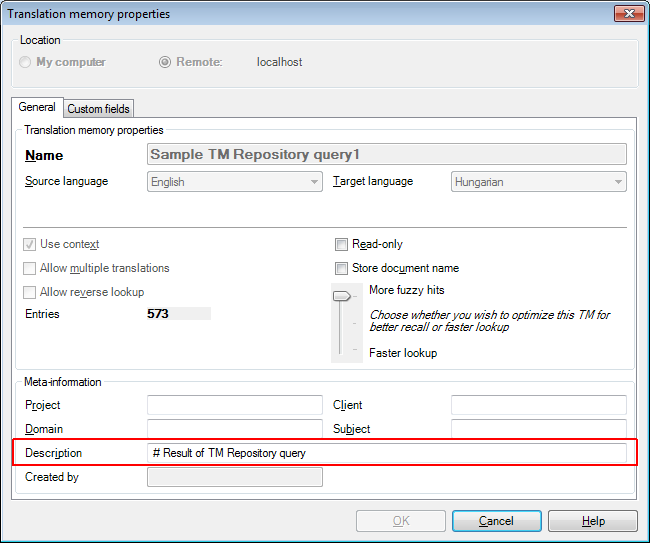|
If you use both a memoQ server and a TM Repository server, you can use the content from the TM Repository database on your memoQ server. To use content from the TM Repository, you need to query the database first. You need to specify some meta-information: descriptive details that belong to your current project. memoQ uses these descriptive details to extract a set of translation units from the TM Repository, and create a server-based translation memory from them. You can use TM Repository content in both local and online projects. However, the translation memory created from the database contents must be on a memoQ server that is connected to a TM Repository server. To retrieve translation memory contents from the TM Repository, and use it in memoQ, follow the steps below: 1.Set up the connection between your memoQ server and the TM Repository server, or contact the administrator of memoQ server to do this. See also: How to connect memoQ server to a TM Repository server. 2.Create a local or an online project. If you are creating an online project, make sure you create it on the memoQ server that is connected to TM Repository. See also: Note: From this point on, you can use either Project home or the memoQ online project window to query the TM Repository, depending on whether you are working with a local or an online project. The description refers to both places, but the screenshots are from Project home. 3.If possible, fill in descriptive information on the project, either on the opening page of the New memoQ project wizard or the Create new online project wizard. To fill in these details after the project is created, navigate to the Settings pane of Project home or the memoQ online project window. 4.Navigate to the Translation memories pane in the memoQ online project window. 5.Click Query repository. The Query repository wizard starts. 6.Follow the screens of the Query repository wizard to put together your query. For details, see the detailed description of the Query repository wizard. In the query criteria, memoQ will automatically fill in those fields that are also filled in among the project details. 7.After you click Finish in the Query repository wizard, a progress window appears:
However, the TM Repository system cannot provide progress information, and this is reported in the dialog. Click Hide to continue the query in the background. Important: Do not click Cancel because that will also abort the query. Note: If you leave the progress dialog open, memoQ will automatically close it when the query finishes. 8.You are returned to the list of translation memories. In the toolbar, next to the Server URL box, click Select. This refreshes the list of translation memories. 9.In the list, look for the translation memory that you specified in the Query repository wizard. Right-click the name of the translation memory, and choose Properties from the popup menu.
If the query has run successfully, the Description field will show # Result of TM Repository query. If the query is still in progress, the Description field shows # TM Repository query in progress. During the query, you cannot access the translation memory. After the query finishes, the translation memory becomes available. 10.Click Cancel to dismiss the Translation memory properties dialog. Using the TM Repository-based translation memory for translationIn the Translation memories pane of the memoQ online project window, check the check box of the new translation memory. It is also recommended that you set this translation memory as primary: right-click the name of the translation memory, and choose Set As Working from the popup menu. If you set the TM Repository-based translation memory as the primary one, all new segments you (or your team members) confirm in the documents will be stored in this translation memory. From this translation memory, memoQ can automatically update the contents in the TM Repository, adding new translation units, and creating new versions of existing ones. Once the translation of the documents is finished, you have two options to update TM Repository with new and changed content in the translation memory. First, you can update the repository directly from documents: 1.Open the project – or, if it is an online project, open a locally checked-out copy of it. On the Preparation ribbon tab, choose Confirm And Update. The Confirm and update rows dialog appears:
2.Check the Also update TM Repository check box, and then click OK. memoQ will confirm all segments, and save the translations in the primary translation memory. Then, if the primary translation memory is TM Repository-based, memoQ will update the TM Repository as well. Alternatively, if the translated segments are all in the primary translation memory, you can navigate to the Translation memories pane in the memoQ online project window. Right-click the name of the TM Repository-based translation memory, and choose Update Repository from the popup menu. Note: TM Repository cannot provide progress information on the update process either. In the progress dialog, click Hide to make the process run in the background. Because both the query and the update are performed by memoQ server, they continue to run even after you close the memoQ desktop program.
|


